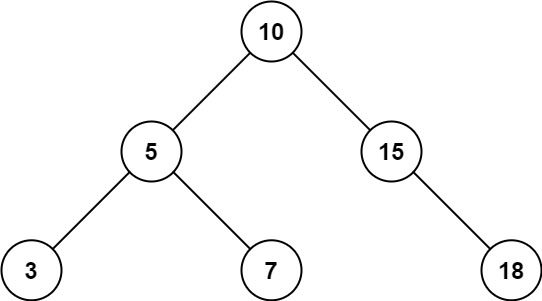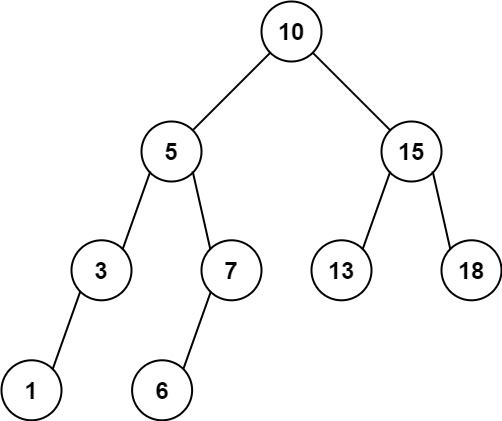| comments | difficulty | edit_url | tags | ||||
|---|---|---|---|---|---|---|---|
true |
简单 |
|
给定二叉搜索树的根结点 root,返回值位于范围 [low, high] 之间的所有结点的值的和。
示例 1:
输入:root = [10,5,15,3,7,null,18], low = 7, high = 15 输出:32
示例 2:
输入:root = [10,5,15,3,7,13,18,1,null,6], low = 6, high = 10 输出:23
提示:
- 树中节点数目在范围
[1, 2 * 104]内 1 <= Node.val <= 1051 <= low <= high <= 105- 所有
Node.val互不相同
我们设计一个函数
函数
- 如果
$root$ 为空,返回$0$ 。 - 如果
$root$ 的值$x$ 在范围$[low, high]$ 之间,那么函数$dfs(root)$ 的初始答案就是$x$ ,否则为$0$ 。 - 如果
$x > low$ ,说明$root$ 的左子树中可能有值在范围$[low, high]$ 之间的结点,所以我们需要递归调用$dfs(root.left)$ ,并将结果加到答案上。 - 如果
$x < high$ ,说明$root$ 的右子树中可能有值在范围$[low, high]$ 之间的结点,所以我们需要递归调用$dfs(root.right)$ ,并将结果加到答案上。 - 最后返回答案。
时间复杂度
# Definition for a binary tree node.
# class TreeNode:
# def __init__(self, val=0, left=None, right=None):
# self.val = val
# self.left = left
# self.right = right
class Solution:
def rangeSumBST(self, root: Optional[TreeNode], low: int, high: int) -> int:
def dfs(root: Optional[TreeNode]) -> int:
if root is None:
return 0
x = root.val
ans = x if low <= x <= high else 0
if x > low:
ans += dfs(root.left)
if x < high:
ans += dfs(root.right)
return ans
return dfs(root)/**
* Definition for a binary tree node.
* public class TreeNode {
* int val;
* TreeNode left;
* TreeNode right;
* TreeNode() {}
* TreeNode(int val) { this.val = val; }
* TreeNode(int val, TreeNode left, TreeNode right) {
* this.val = val;
* this.left = left;
* this.right = right;
* }
* }
*/
class Solution {
public int rangeSumBST(TreeNode root, int low, int high) {
return dfs(root, low, high);
}
private int dfs(TreeNode root, int low, int high) {
if (root == null) {
return 0;
}
int x = root.val;
int ans = low <= x && x <= high ? x : 0;
if (x > low) {
ans += dfs(root.left, low, high);
}
if (x < high) {
ans += dfs(root.right, low, high);
}
return ans;
}
}/**
* Definition for a binary tree node.
* struct TreeNode {
* int val;
* TreeNode *left;
* TreeNode *right;
* TreeNode() : val(0), left(nullptr), right(nullptr) {}
* TreeNode(int x) : val(x), left(nullptr), right(nullptr) {}
* TreeNode(int x, TreeNode *left, TreeNode *right) : val(x), left(left), right(right) {}
* };
*/
class Solution {
public:
int rangeSumBST(TreeNode* root, int low, int high) {
function<int(TreeNode*)> dfs = [&](TreeNode* root) {
if (!root) {
return 0;
}
int x = root->val;
int ans = low <= x && x <= high ? x : 0;
if (x > low) {
ans += dfs(root->left);
}
if (x < high) {
ans += dfs(root->right);
}
return ans;
};
return dfs(root);
}
};/**
* Definition for a binary tree node.
* type TreeNode struct {
* Val int
* Left *TreeNode
* Right *TreeNode
* }
*/
func rangeSumBST(root *TreeNode, low int, high int) int {
var dfs func(*TreeNode) int
dfs = func(root *TreeNode) (ans int) {
if root == nil {
return 0
}
x := root.Val
if low <= x && x <= high {
ans += x
}
if x > low {
ans += dfs(root.Left)
}
if x < high {
ans += dfs(root.Right)
}
return
}
return dfs(root)
}/**
* Definition for a binary tree node.
* class TreeNode {
* val: number
* left: TreeNode | null
* right: TreeNode | null
* constructor(val?: number, left?: TreeNode | null, right?: TreeNode | null) {
* this.val = (val===undefined ? 0 : val)
* this.left = (left===undefined ? null : left)
* this.right = (right===undefined ? null : right)
* }
* }
*/
function rangeSumBST(root: TreeNode | null, low: number, high: number): number {
const dfs = (root: TreeNode | null): number => {
if (!root) {
return 0;
}
const { val, left, right } = root;
let ans = low <= val && val <= high ? val : 0;
if (val > low) {
ans += dfs(left);
}
if (val < high) {
ans += dfs(right);
}
return ans;
};
return dfs(root);
}/**
* Definition for a binary tree node.
* public class TreeNode {
* public int val;
* public TreeNode left;
* public TreeNode right;
* public TreeNode(int val=0, TreeNode left=null, TreeNode right=null) {
* this.val = val;
* this.left = left;
* this.right = right;
* }
* }
*/
public class Solution {
public int RangeSumBST(TreeNode root, int low, int high) {
return dfs(root, low, high);
}
private int dfs(TreeNode root, int low, int high) {
if (root == null) {
return 0;
}
int x = root.val;
int ans = low <= x && x <= high ? x : 0;
if (x > low) {
ans += dfs(root.left, low, high);
}
if (x < high) {
ans += dfs(root.right, low, high);
}
return ans;
}
}
